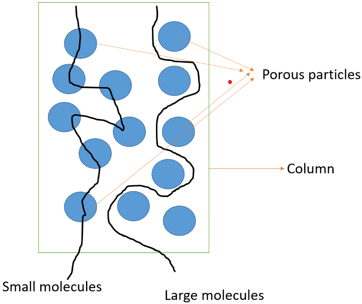This set of Enzyme Technology Multiple Choice Questions & Answers (MCQs) focuses on “Enzymes Purification – Gel Filtration”.
1. _______________ is a liquid column chromatographic method of separating solute molecules according to differences in molecular size.
a) Thin layer chromatography (TLC)
b) Ion exchange chromatography
c) Gel filtration
d) Affinity chromatography
View Answer
Explanation: The liquid chromatographic method of separating solute molecules according to differences in molecular size is referred to as gel filtration. TLC is a type of chromatography wherein the stationary phase is immobilized on a glass or plastic plate and organic solvent acts as the mobile phase. Ion-exchange and affinity chromatography are used in enzyme preparation according to the property of the enzyme.
2. Which of the following technique separates the sample by percolating it through a bed of porous, uncharged particles?
a) Gel filtration
b) Filtration
c) Dialysis
d) Ultrafiltration
View Answer
Explanation: Gel filtration separates the sample by percolating it through a bed of porous, uncharged particles. Filtration simply separates based on the size across a permeable membrane. Ultrafiltration is a type crossflow microfiltration technique where in the sample flow is tangential to the membrane to avoid the building of the cake. Dialysis is a process which allows the passage of low molecular weight compounds retaining the high molecular weight compounds inside the membrane.
3. Which of the following is not a step involved in gel filtration?
a) Gel preparation
b) Precipitation
c) Sample application
d) Elution of the sample
View Answer
Explanation: Precipitation is the step involved in purification of enzyme or protein. Gel filtration is a technique used to purify enzyme or protein. The steps involved are as follows:
(i) Gel preparation by using sponge like porous material which is equilibrated an applied in the column.
(ii) Sample application to the column which consists of different molecules.
(iii) To elute the sample, same solvent is applied to the column. Large molecules which cannot penetrate the gel, pass the column faster and get eluted first and smaller molecules they get penetrate the gel and take a longer time elute and thus, separating the sample of interest.
4. Which of the following is not a gel filtration media used in gel filtration?
a) Agarose gel
b) Polyacrylamide gels
c) Sephadex
d) Silica gel
View Answer
Explanation: Silica gel is used as an adsorbent in stationary phase of TLC. In gel filtration, commonly used gels are crossed dextran gels (sephadex), polyacrylamide gels (Biogel -P) and agarose gels (Biogel – A).
5. Which gel filtration media is used to purify alpha amylase by gel filtration?
a) Biogel – P
b) Sephacryl S-300
c) Biogel – A
d) Sephadex
View Answer
Explanation: Sephacryl S-300 is used as the gel filtration media to purify alpha amylase by gel filtration. The column is equilibrated with NaCl and the sample of interest in eluted with NaCl of different concentration. Others commonly used gel filtration media are biogel – P, biogel – A and sephadex.
6. Alkaline protease is purified by gel filtration using __________ as gel filtration media.
a) Sephacryl S-300
b) Biogel – P
c) Sephadex G-100
d) Agarose gel
View Answer
Explanation: Crude alkaline protease is subjected to ammonium sulphate precipitation followed by dialysis against 0.1 M Tris-HCl. This sample is then applied on the sephadex G-100 gel equilibrated with 0.1 M Tris-HCl and eluted with the same buffer. Sephacryl S-300 is used to purify alpha amylase. Biogel – P and agarose are other commonly used gels for gel filtration.
7. What does the schematic diagram below represent?

a) Gel filtration
b) Affinity chromatography
c) Dialysis
d) Filtration
View Answer
Explanation: In the above diagram, gel filtration schematic diagram is shown. There is a column filled with porous particles. The sample mixture is applied to the column. The smaller molecules get entrapped in the porous gel and elute at much later time as compared to larger molecules which elute faster as they do not enter the porous gel particles. Hence the required sample of interest is obtained. Alpha amylase and alkaline protease are purified by this method.
8. Smaller molecules elute faster than larger molecules during gel filtration.
a) True
b) False
View Answer
Explanation: During gel filtration, smaller molecules penetrate the porous membrane and are temporary held by the gel and their migration would be delayed through the column. Whereas large molecules rapidly move through the column within the space between gel particles and thus quickly eluted. Hence the above statement is false.
9. Pick the odd one out.
a) Gel filtration
b) Gel permeation chromatography
c) Ion-exchange chromatography
d) Restricted-diffusion chromatography
View Answer
Explanation: Ion exchange chromatography is the odd one out. As gel filtration, gel permeation and restricted-diffusion chromatography are one and the same. It is a liquid column chromatographic method of separating solute molecules according to their size.
Sanfoundry Global Education & Learning Series – Enzyme Technology.
To practice all areas of Enzyme Technology, here is complete set of 1000+ Multiple Choice Questions and Answers.
If you find a mistake in question / option / answer, kindly take a screenshot and email to [email protected]
- Check Chemical Engineering Books
- Practice Chemical Engineering MCQs
- Apply for Chemical Engineering Internship
- Check Enzyme Technology Books
- Apply for Biotechnology Internship
